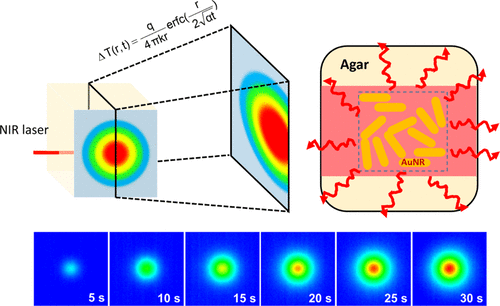Our official English website, www.x-mol.net, welcomes your feedback! (Note: you will need to create a separate account there.)
Thermographic Detection and Analysis of the Temporal and Spatial Evolution of Temperature upon Optical Heating of Gold Nanorod Assembly Immobilized in Agar
ACS Omega ( IF 4.1 ) Pub Date : 2018-12-10 00:00:00 , DOI: 10.1021/acsomega.8b02794 Chia-Yu Ho,Li-Kang Chu
ACS Omega ( IF 4.1 ) Pub Date : 2018-12-10 00:00:00 , DOI: 10.1021/acsomega.8b02794 Chia-Yu Ho,Li-Kang Chu

|
Photoexcitation of the longitudinal surface plasmon resonance band of gold nanorods (AuNRs) in the near-infrared region has been widely employed in photothermal therapy. Generally, the temperature evolution of the surface of the object of interest reflects the photothermal efficiency. However, the temperature in the object interior may be higher than required and cause unwanted damage to the healthy cells or tissues in the vicinity of the unhealthy areas. In this work, agar served as a biomimicking tissue, and 1 mm3 AuNR agar assembly cubes were placed at different depths with respect to the agar surface and excited with an 808 nm continuous-wave laser or an 850 nm light-emitting diode light. The evolution of the surface temperature was monitored with an infrared thermographic camera and analyzed with a point heat source model. The concentric temperature change suggested that the sample was nonfluidic and that convection and mass flow could be excluded. The depths of the AuNR agar cubes could be determined and were consistent with the prepared depths. Thus, using the agar matrix and AuNRs with optical heating and monitoring, in combination with the point heat source model, is feasible for the analysis of the surface and interior temperature evolutions of the object and the further determination of the initial conditions of systems, such as the positions of the heat source, the injection power, and so on.
中文翻译:

光学加热固定在琼脂中的金纳米棒组件的温度时空变化的热成像检测和分析
金纳米棒(AuNRs)在近红外区域的纵向表面等离子体共振带的光激发已广泛用于光热疗法中。通常,目标物体表面的温度变化反映了光热效率。但是,物体内部的温度可能会高于所需温度,并且会对不健康区域附近的健康细胞或组织造成不必要的损害。在这项工作中,琼脂用作生物模仿组织,而1 mm 3将AuNR琼脂组装立方体放置在相对于琼脂表面的不同深度处,并用808 nm连续波激光器或850 nm发光二极管光激发。用红外热像仪监测表面温度的变化,并用点热源模型进行分析。同心温度变化表明样品为非流体样品,可以排除对流和质量流量。可以确定AuNR琼脂块的深度,并且与准备的深度一致。因此,将琼脂基质和AuNRs与光学加热和监测结合使用,再结合点热源模型,对于分析对象的表面和内部温度变化以及进一步确定系统的初始条件是可行的,
更新日期:2018-12-10
中文翻译:

光学加热固定在琼脂中的金纳米棒组件的温度时空变化的热成像检测和分析
金纳米棒(AuNRs)在近红外区域的纵向表面等离子体共振带的光激发已广泛用于光热疗法中。通常,目标物体表面的温度变化反映了光热效率。但是,物体内部的温度可能会高于所需温度,并且会对不健康区域附近的健康细胞或组织造成不必要的损害。在这项工作中,琼脂用作生物模仿组织,而1 mm 3将AuNR琼脂组装立方体放置在相对于琼脂表面的不同深度处,并用808 nm连续波激光器或850 nm发光二极管光激发。用红外热像仪监测表面温度的变化,并用点热源模型进行分析。同心温度变化表明样品为非流体样品,可以排除对流和质量流量。可以确定AuNR琼脂块的深度,并且与准备的深度一致。因此,将琼脂基质和AuNRs与光学加热和监测结合使用,再结合点热源模型,对于分析对象的表面和内部温度变化以及进一步确定系统的初始条件是可行的,



























 京公网安备 11010802027423号
京公网安备 11010802027423号